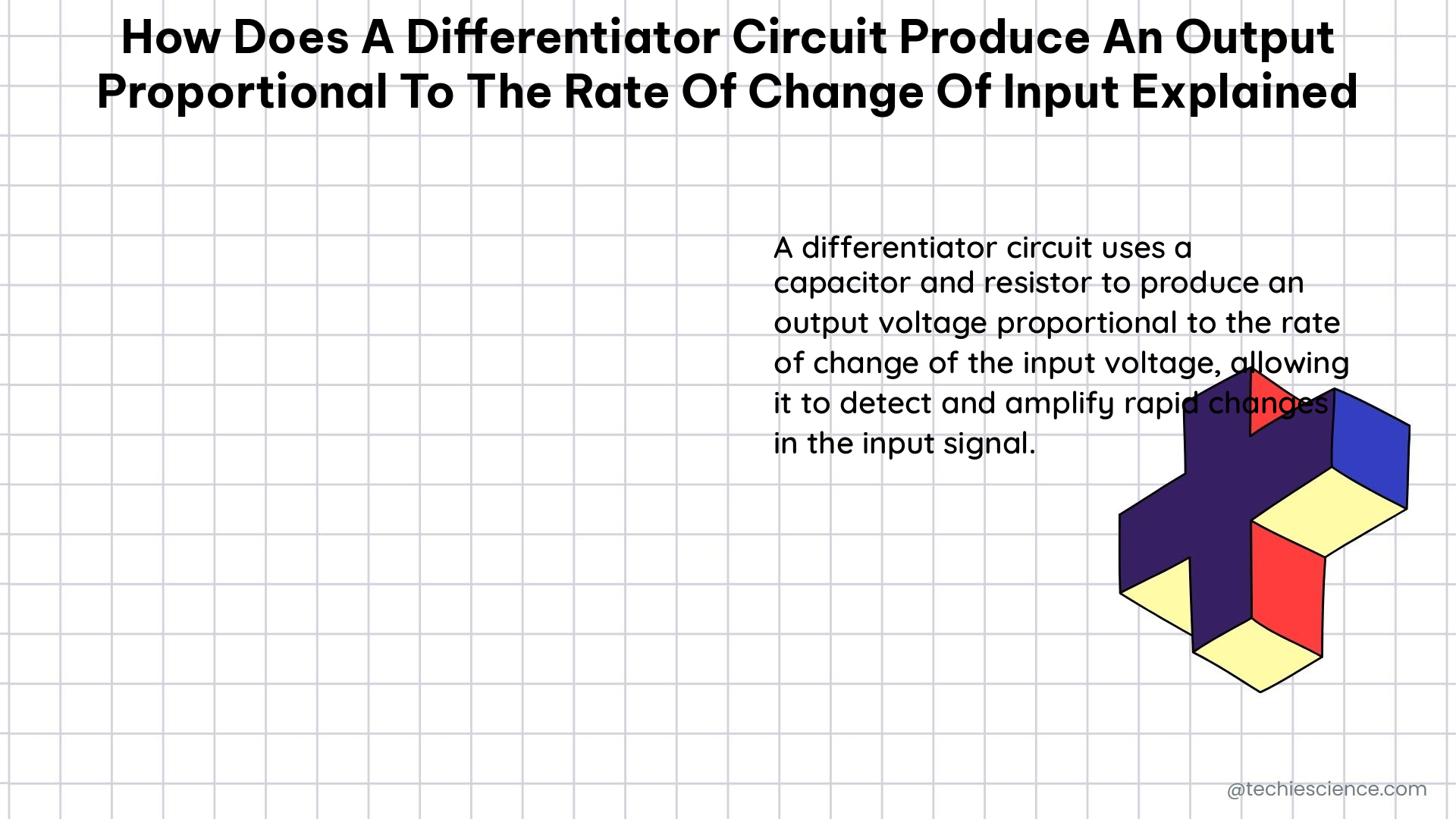A differentiator circuit is a fundamental building block in electronic systems, responsible for producing an output that is proportional to the rate of change of the input signal. This powerful functionality has numerous applications, from signal processing and control systems to instrumentation and data analysis. In this comprehensive guide, we will delve into the intricate workings of the differentiator circuit, exploring its underlying principles, design considerations, and practical implementation.
Understanding the Differentiator Circuit
At the heart of a differentiator circuit lies the combination of a capacitor and a resistor, strategically arranged to create a specific configuration. This configuration allows the circuit to generate an output voltage (Vout) that is proportional to the rate of change of the input voltage (Vin) over time. The mathematical relationship between these variables is expressed by the formula:
Vout = -RC * dVin/dt
Where:
– Vout is the output voltage
– R is the resistance
– C is the capacitance
– dVin/dt is the rate of change of the input voltage with respect to time
The time constant (τ) of a differentiator circuit is determined by the product of the resistance (R) and capacitance (C), as given by the equation:
τ = RC
This time constant plays a crucial role in determining the circuit’s response to changes in the input voltage. A smaller time constant results in a faster response, while a larger time constant leads to a slower response.
Frequency Response and Transfer Function

The frequency response of a differentiator circuit is characterized by its transfer function, which is expressed as:
H(s) = -sRC
Where:
– s is the complex frequency variable
The magnitude of the transfer function increases at a rate of 20 dB per decade with increasing frequency, while the phase shift is -90 degrees. This means that the circuit’s output will amplify higher-frequency components of the input signal more than lower-frequency components, effectively differentiating the input.
Practical Applications and Considerations
Differentiator circuits find widespread use in various applications, particularly in situations where the rate of change of a signal is of interest. One common application is the differentiation of square waves, where the circuit’s output produces a series of positive and negative spikes corresponding to the transitions in the input signal.
When designing a practical differentiator circuit, it is essential to consider the stability and noise performance of the circuit. To address these concerns, additional components can be added, such as:
- A resistor (R1) in series with the input capacitor: This helps to stabilize the circuit and prevent oscillations at high frequencies.
- A capacitor (Cf) in parallel with the feedback resistor: This capacitor helps to reduce noise and improve the circuit’s stability.
By adjusting the values of the resistor and capacitor, the gain of the differentiator circuit can be fine-tuned to meet the specific requirements of the application.
Quantifiable Data Points
To provide a more comprehensive understanding of differentiator circuits, let’s explore some quantifiable data points:
-
Time Constant (τ): The time constant of a differentiator circuit is given by the product of the resistance (R) and capacitance (C), as expressed by the equation τ = RC. Typical values for the time constant can range from microseconds to milliseconds, depending on the specific circuit design.
-
Frequency Response: The transfer function of a differentiator circuit is H(s) = -sRC. The magnitude of the transfer function increases at a rate of 20 dB per decade with increasing frequency, while the phase shift is -90 degrees. This means that the circuit’s output will amplify higher-frequency components more than lower-frequency components.
-
Gain Adjustment: The gain of a practical differentiator circuit can be adjusted by changing the values of the resistor (R) and capacitor (C). Typical gain values can range from 0.1 to 10, depending on the specific application requirements.
-
Stabilization and Noise Reduction: The addition of a resistor (R1) in series with the input capacitor and a capacitor (Cf) in parallel with the feedback resistor can help to stabilize the circuit and reduce noise. Typical values for R1 and Cf can range from 1 kΩ to 10 kΩ and 10 nF to 100 nF, respectively, depending on the circuit design.
-
Bandwidth: The bandwidth of a differentiator circuit is determined by the time constant (τ) and the desired level of gain. Typical bandwidth values can range from a few hundred hertz to several kilohertz, depending on the specific circuit design and application requirements.
Conclusion
The differentiator circuit is a powerful tool in the world of electronics, capable of producing an output that is proportional to the rate of change of the input signal. By understanding the underlying principles, design considerations, and practical applications of this circuit, electronics engineers and enthusiasts can unlock a wealth of possibilities in signal processing, control systems, and beyond. This comprehensive guide has provided a deep dive into the intricacies of the differentiator circuit, equipping you with the knowledge and insights to master this essential electronic building block.
Reference:
- Differentiator Circuits – Electronics Tutorials
- Operational Amplifier Differentiator Circuit – Electronics Notes
- Practical Op-Amp Differentiator Circuit – Electronics Tutorials

The lambdageeks.com Core SME Team is a group of experienced subject matter experts from diverse scientific and technical fields including Physics, Chemistry, Technology,Electronics & Electrical Engineering, Automotive, Mechanical Engineering. Our team collaborates to create high-quality, well-researched articles on a wide range of science and technology topics for the lambdageeks.com website.
All Our Senior SME are having more than 7 Years of experience in the respective fields . They are either Working Industry Professionals or assocaited With different Universities. Refer Our Authors Page to get to know About our Core SMEs.